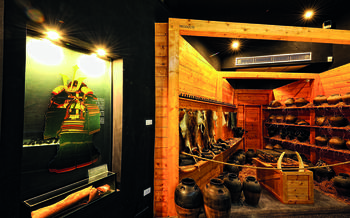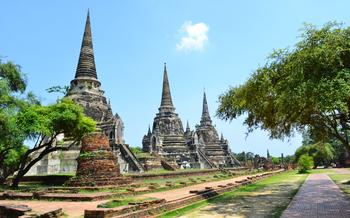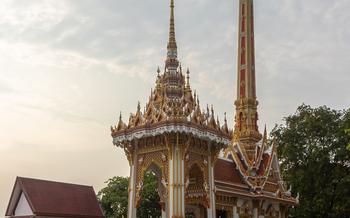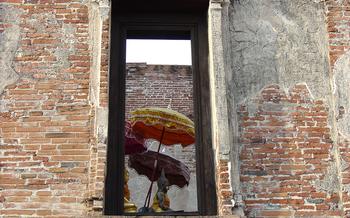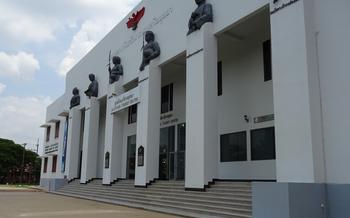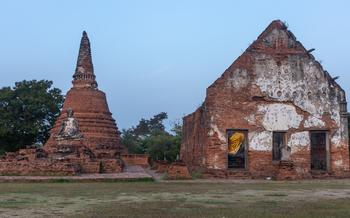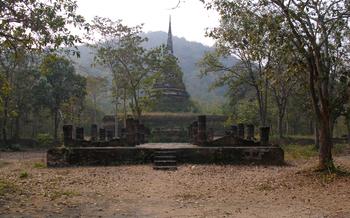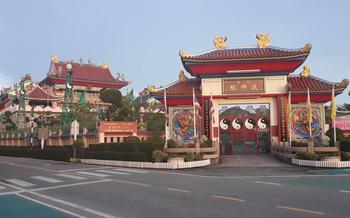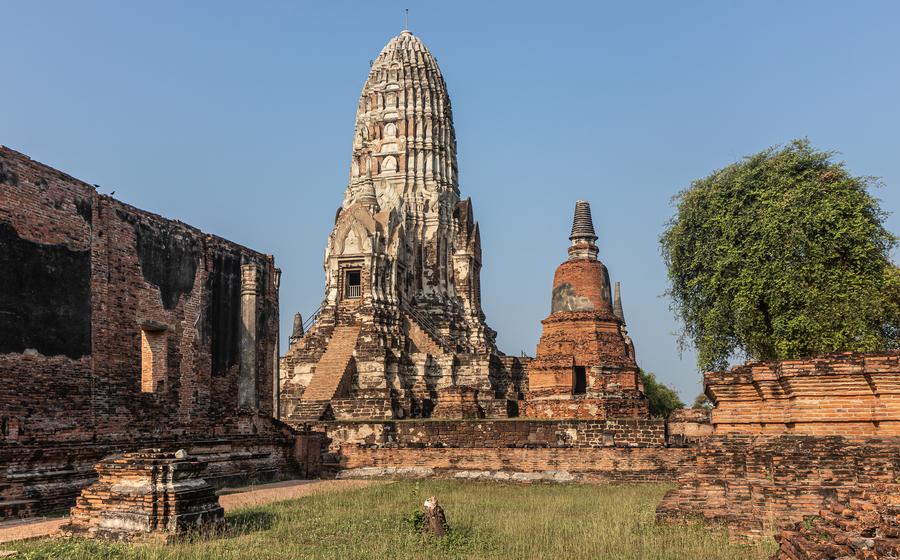
Wat Ratchaburana
- Wat Ratchaburana: A Historical Gem
- Exploring the Temple Grounds
- The Prang Towers: A Symbol of Resilience
- Crypts and Hidden Chambers
- Impressive Buddha Images
- Stunning Wall Paintings: A Window to the Past
- Ayutthaya Historical Park: A UNESCO World Heritage Site
- Experiencing Wat Ratchaburana at Night
- Local Markets and Street Food
- Transportation to Wat Ratchaburana
- Accommodation Near the Temple
- Visitor Information and Accessibility
- Nearby Attractions and Activities
- Insider Tip: Photography Opportunities
Wat Ratchaburana: A Historical Gem
Wat Ratchaburana is a magnificent temple located in the ancient city of Ayutthaya, Thailand. It is a testament to the rich history and cultural heritage of the country and is widely renowned for its historical significance, architectural features, and unique characteristics. Built in the 15th century during the reign of King Borommarachathirat II, the temple served as a royal monastery and was constructed to commemorate the victory over the Burmese.
The architectural style of Wat Ratchaburana is a blend of Khmer and Ayutthayan elements, showcasing intricate carvings and decorative details. The temple complex consists of a central prang (spire), two smaller prangs, and several other structures, including a viharn (assembly hall), ubosot (ordination hall), and chedi (stupa). Each structure is adorned with delicate stucco and stone carvings, depicting various scenes from Buddhist mythology and history, adding to the overall grandeur of the temple.
One of the most striking features of Wat Ratchaburana is the presence of two unique prang towers. These towers are decorated with intricate carvings and bas-reliefs, showcasing scenes from the Ramayana epic and other Buddhist stories. The prang towers have undergone extensive restoration efforts, preserving their original beauty and retaining their symbolic significance.
The temple is an active place of worship and holds great religious significance for the local community. It is a popular destination for both Thai and international tourists, offering a glimpse into the rich history and cultural traditions of Thailand.
Exploring the Temple Grounds
Wat Ratchaburana's layout is characterized by a central prang, surrounded by a series of chapels, stupas, and other structures. The temple's most striking feature is its three prang towers, which rise majestically above the rest of the complex. These towers are adorned with intricate carvings and sculptures, depicting scenes from Buddhist mythology and history.
Within the temple grounds, visitors can also find several notable structures, including the main ordination hall, the viharn, which houses a large Buddha image and is used for religious ceremonies. The temple also features a number of smaller chapels and stupas, each with its own unique architectural features and religious significance.
The symbolism and religious significance of Wat Ratchaburana are deeply intertwined. The temple's layout and architecture are designed to represent the Buddhist cosmology, with the central prang representing Mount Meru, the mythical center of the universe. The stupas and chapels represent the various realms of existence, and the Buddha images symbolize the path to enlightenment.
To fully appreciate the beauty and significance of Wat Ratchaburana, it's recommended to take your time exploring the temple grounds. Wander through the different structures, admire the intricate details, and soak in the serene atmosphere.
The Prang Towers: A Symbol of Resilience
The prang towers of Wat Ratchaburana are a striking feature of the temple complex, rising majestically above the other structures. These impressive towers are unique in their design, featuring a distinctive stepped pyramid shape that tapers towards the top. The prangs were constructed using a combination of brick and laterite, and their exteriors are adorned with intricate stucco decorations and bas-relief carvings depicting scenes from Buddhist mythology.
The history of the prang towers is closely intertwined with the tumultuous events that befell Ayutthaya. During the Burmese invasion of 1767, the temple was heavily damaged, and the prang towers were partially destroyed. The towers remained in ruins for over two centuries until the Fine Arts Department of Thailand undertook a major restoration project in the early 20th century. The restoration work involved painstakingly reconstructing the damaged sections of the towers using traditional techniques and materials, ensuring that their original beauty and grandeur were preserved.
Today, the prang towers of Wat Ratchaburana stand as a testament to the resilience and perseverance of the Thai people. Their survival through centuries of war and natural disasters is a reminder of the enduring spirit of Ayutthaya and the importance of preserving its rich cultural heritage. The towers serve as a symbol of the strength and resilience of the Thai people, who have repeatedly rebuilt and restored their beloved temples, ensuring that their legacy continues to inspire future generations.
Crypts and Hidden Chambers
The discovery of hidden chambers and crypts beneath the temple grounds of Wat Ratchaburana was a groundbreaking moment in Thai archaeology. These subterranean vaults were concealed for centuries, revealing a treasure trove of artifacts and secrets that shed light on the temple's rich history and significance.
The crypts were stumbled upon during renovation work in the 1950s, and their contents astounded experts. Inside, they found a wealth of artifacts, including gold ornaments, precious stones, and ceramic wares. These items provided valuable insights into the temple's construction, rituals, and the lives of its former inhabitants.
The chambers also contained the remains of several high-ranking individuals, including members of the royal family and high-ranking monks. The discovery of these crypts has helped historians to piece together the temple's history and understand the importance it held in the Ayutthaya Kingdom.
Theories abound about the purpose of these crypts and chambers. Some believe they were used as secret hiding places for valuables during times of war or conflict. Others suggest that they served as meditation chambers for monks seeking spiritual enlightenment. Regardless of their exact purpose, these hidden chambers offer a glimpse into the fascinating world of Ayutthaya's past.
Impressive Buddha Images
Wat Ratchaburana houses a collection of awe-inspiring Buddha images, each possessing unique features and styles that reflect different periods of Thai art and history. The temple's Buddha images are highly revered and hold deep religious significance for both monks and devotees.
One of the most striking images is the colossal bronze Buddha statue located in the main chapel. Standing tall at over three meters, this majestic Buddha exudes an aura of serenity and compassion. The statue's intricate details and exquisite craftsmanship showcase the artistic prowess of Ayutthaya's artisans.
In addition to the bronze Buddha, there are numerous smaller Buddha images scattered throughout the temple grounds, each with its own distinct characteristics. Some images are crafted from gold, silver, or wood, while others are adorned with precious stones and intricate carvings. The variety of styles represents the different artistic influences that have shaped Thai Buddhist art over the centuries.
The Buddha images at Wat Ratchaburana are not merely objects of art; they are also imbued with deep religious symbolism. Each image represents a different aspect of the Buddha's teachings, such as compassion, wisdom, or enlightenment. Devotees often pray and meditate in front of these images, seeking guidance and inspiration from the Buddha's teachings.
Stories and legends associated with the Buddha images add to their mystique. According to one legend, the bronze Buddha statue was once stolen by Burmese invaders. However, a miraculous event occurred, and the statue returned to its rightful place in Wat Ratchaburana. This story underscores the deep devotion and reverence that the Thai people have for these sacred images.
Whether you are a devout Buddhist, a history enthusiast, or simply an admirer of art, the Buddha images at Wat Ratchaburana are sure to leave a lasting impression. These sacred images are a testament to the rich cultural heritage and artistic achievements of Thailand.
Stunning Wall Paintings: A Window to the Past
The walls of Wat Ratchaburana are adorned with exquisite paintings that offer a glimpse into the past. These murals depict scenes from Buddhist mythology, historical events, and everyday life in Ayutthaya. The paintings are a testament to the skill and artistry of the Thai craftsmen who created them.
The paintings were created using a variety of techniques, including tempera, fresco, and secco. The artists used natural pigments derived from minerals, plants, and insects to create a vibrant and colorful palette. The paintings are remarkably well-preserved, considering their age, and provide a valuable record of Thai history and culture.
The paintings at Wat Ratchaburana are not only beautiful, but they are also significant from a historical and cultural perspective. They provide a glimpse into the beliefs, values, and customs of the people of Ayutthaya. The paintings also offer insights into the everyday life of the people, including their clothing, food, and entertainment.
The paintings at Wat Ratchaburana are a must-see for anyone interested in Thai history and culture. They are a beautiful and evocative record of a bygone era.
Ayutthaya Historical Park: A UNESCO World Heritage Site
Wat Ratchaburana is part of the Ayutthaya Historical Park, a vast complex of ancient temples and ruins that has been designated as a UNESCO World Heritage Site. This prestigious recognition highlights the park's outstanding universal value as a cultural and historical treasure.
Within the park, visitors can explore a myriad of other temples and ruins, each with its unique charm and significance. The Wat Mahathat, with its iconic head of Buddha entwined by tree roots, is a must-see. The Wat Phra Si Sanphet, once the grand royal temple of the Ayutthaya Kingdom, boasts impressive chedis and Buddha images. And the Wat Chaiwatthanaram, with its unique Khmer-style architecture, offers stunning views from its towering prang towers.
The Ayutthaya Historical Park provides a fascinating glimpse into the grandeur and splendor of the ancient Ayutthaya Kingdom. It is a place where history comes alive, and visitors can immerse themselves in the rich cultural heritage of Thailand.
Experiencing Wat Ratchaburana at Night
As the sun sets and the sky transforms into a canvas of vibrant colors, Wat Ratchaburana takes on a new allure. The temple's silhouette against the darkening horizon creates a breathtaking backdrop, casting an ethereal glow upon the ancient ruins. The atmosphere becomes magical as the grounds are illuminated by strategically placed spotlights, highlighting the intricate details of the architecture and casting long, dramatic shadows that dance across the temple complex. This unique perspective offers visitors a chance to experience the temple in a completely different light, revealing hidden details and creating a sense of awe and wonder.
Strolling through the grounds at night allows for a more intimate and serene experience. The absence of daytime crowds provides an opportunity to connect with the temple's spiritual essence and appreciate its beauty without distractions. The soft glow of the lights creates a mystical ambiance, inviting visitors to linger longer and soak in the tranquility of the surroundings.
In addition to the visual spectacle, Wat Ratchaburana at night often hosts special events and festivals that showcase Thai culture and traditions. These events may include traditional dance performances, music concerts, or religious ceremonies, offering visitors a chance to immerse themselves in the local culture and gain a deeper understanding of Thailand's rich heritage.
To fully capture the magic of Wat Ratchaburana at night, consider bringing a tripod and experimenting with long exposure photography. This technique allows you to capture the movement of the stars and create stunning light trails that add a dynamic element to your images. Remember to adjust your camera settings accordingly, using a low ISO and a narrow aperture to minimize noise and achieve sharp, detailed shots.
Local Markets and Street Food
In the vicinity of Wat Ratchaburana, visitors can immerse themselves in the vibrant local markets and street food stalls that line the streets. These bustling marketplaces offer a tantalizing array of Thai delicacies, from fragrant curries and noodle dishes to sweet tropical fruits and refreshing beverages. Indulge in the flavors of pad thai, a stir-fried rice noodle dish with a sweet and tangy sauce, or savor the spicy kick of tom yum soup, a hot and sour broth with shrimp, mushrooms, and lemongrass.
For a truly authentic experience, venture into the lively night market, where vendors set up their stalls under twinkling lights and the air fills with the aromas of grilled meats, fresh seafood, and exotic spices. Here, you can sample a variety of Thai street food favorites, such as grilled squid, crispy roti pancakes, and mango sticky rice, a sweet and savory dessert made with glutinous rice, ripe mangoes, and coconut milk.
To make the most of your culinary adventure, be sure to try some of the local fruits, such as rambutans, mangosteens, and dragonfruit, which are not commonly found outside of Thailand. And don't forget to quench your thirst with a refreshing glass of sugarcane juice or coconut water, both of which are popular beverages in Thailand.
As you navigate the markets and street food stalls, remember to embrace the local culture by interacting with the friendly vendors and trying new and unusual dishes. Thai street food is not just about the food itself; it's also about the experience of immersing yourself in the local way of life and creating lasting memories of your time in Thailand.
Transportation to Wat Ratchaburana
Getting to Wat Ratchaburana from Bangkok is a breeze, with various transportation options available. For a comfortable and direct journey, hop on a train from Bangkok's Hua Lamphong Railway Station. Trains depart frequently, and the ride takes about an hour and a half. Once in Ayutthaya, tuk-tuks and taxis are readily available to take you to the temple for a nominal fee.
If you prefer a more adventurous mode of transport, opt for a bus from Bangkok's Northern Bus Terminal. Buses are generally cheaper than trains, but the journey takes slightly longer, around two hours. From the Ayutthaya bus station, you can take a tuk-tuk or taxi to reach the temple.
For a truly immersive experience, consider renting a bicycle. Several rental shops are located near the train and bus stations. Cycling through the charming streets of Ayutthaya is a fantastic way to explore the city and soak in its rich history. Just remember to ride safely and be mindful of other road users.
When negotiating transportation costs, particularly with tuk-tuk drivers, don't hesitate to bargain politely. Locals are generally friendly and willing to accommodate reasonable requests. With a bit of negotiation, you can secure a fair price for your journey.
Accommodation Near the Temple
When planning your trip to Wat Ratchaburana, you'll want to consider your accommodation options. There are several hotels and guesthouses located near the temple, offering a range of options to suit different budgets and preferences.
For those seeking a luxurious stay, the Ayutthaya Riverfront Hotel is an excellent choice. This five-star hotel offers stunning views of the Chao Phraya River and is just a short walk from the temple. The hotel features elegant rooms and suites, as well as a swimming pool, spa, and fitness center.
If you're looking for a more affordable option, there are several guesthouses and hostels located within walking distance of Wat Ratchaburana. These guesthouses offer basic but comfortable accommodations, and many of them have rooftop terraces with views of the temple.
When choosing your accommodation, consider the distance to the temple, as well as the amenities and services that are important to you. Some guesthouses offer free breakfast, while others have laundry facilities or tour desks. It's also a good idea to read reviews from previous guests to get a sense of the quality of the accommodation and the level of service you can expect.
No matter where you choose to stay, you'll be able to easily explore Wat Ratchaburana and the surrounding area. The temple is just a short walk from the main road, and there are plenty of tuk-tuks and taxis available to take you to other attractions in Ayutthaya.
Visitor Information and Accessibility
Wat Ratchaburana is open to visitors daily from 8:00 AM to 6:00 PM. The entrance fee is 50 baht for foreign tourists and 20 baht for Thai citizens. The temple is wheelchair accessible, with ramps and elevators available for visitors with disabilities. Guided tours in English and Thai are offered for a small additional fee, and audio guides are also available for rent.
To make the most of your visit, it is recommended to plan your trip during the cooler months (November to February) to avoid the intense heat. Comfortable shoes are essential for walking around the temple grounds, and a hat and sunglasses are recommended for sun protection. Remember to dress respectfully, covering your shoulders and knees, and avoid wearing shorts or tank tops.
Photography is allowed within the temple grounds, but it is important to be mindful of the monks and other visitors when taking photos. Flash photography is not permitted, and tripods are not allowed inside the temple buildings.
Nearby Attractions and Activities
Wat Ratchaburana is not the only attraction that Ayutthaya has to offer. Other temples and historical sites, such as Wat Phra Si Sanphet, Wat Yai Chai Mongkhon, and Wat Mahathat, are all within a short distance and are worth exploring. You can also take a boat trip or river cruise along the Chao Phraya River to see the city from a different perspective. In the evening, you can enjoy cultural performances and shows that showcase the rich heritage of Ayutthaya. To make the most of your time in Ayutthaya, plan your itinerary carefully to include a variety of activities and attractions. This will ensure that you have a memorable and enriching experience in this historic city.
Insider Tip: Photography Opportunities
Wat Ratchaburana offers a treasure trove of photographic opportunities for enthusiasts of all levels. The best time to capture the temple's splendor is during the golden hours of sunrise and sunset, when the warm light casts a magical glow on the ancient ruins. For stunning shots of the prang towers, position yourself at a low angle to emphasize their height and grandeur. Experiment with different perspectives by exploring the temple grounds and finding unique angles that showcase the intricate details of the architecture. Don't be afraid to play with shutter speeds and apertures to create dynamic effects, such as blurring the movement of clouds or capturing the flow of water in the surrounding canals. Remember to be respectful of other visitors and avoid using flash photography, as it can be disruptive to the serene atmosphere of the temple.
